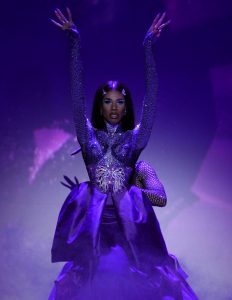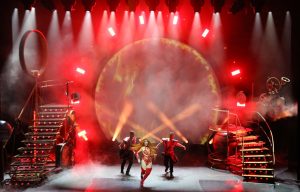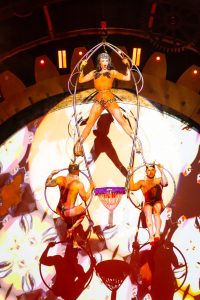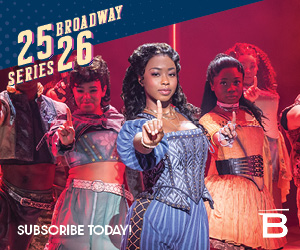By FRANK RIZZO
Photography by Brandon Voss, Voss Events
It started slowly, with my husband Bill becoming a fan first. Eleven years ago, “RuPaul’s Drag Race” was new to Logo, the gay cable channel best known to me at the time for reruns of “The Golden Girls.” Finally, it was offering some original programming that was actually watchable – surprisingly fun, even.
I took a peek at an early show or two and thought it had a great spirit of glam, sass, and an appealing inclusive vibe from these merry bands of gals from beyond the fringe. It had a bit of a low-rent look to it, but hey, it’s drag, I thought. (And what did I know? Apparently not much – yet.)
It took me some time to match the playful names of the contestants with their changing personas for the sometimes silly, sometimes mind-blowing challenges, but the dis was fresh, the challenges a hoot and the looks – well, pretty damn fantastic. Not just glitter-and-be-gay but supremely stylish, provocative, even at times on the edge of couture.

My viewing became more and more regular as the show moved to VH1 – and later became available on Netflix – and the production values, challenges, celebs (OMG! Lady Gaga!) and costumes stepped up with each new season.
Sometime halfway through its 11-year run, it all kicked in. I became a Drag Race obsessive, following each season’s shows, its “Untucked” backstage follow-up programs, its “All Stars” spin-offs, its hashtags, tweets, word coinage, podcasts and recaps. Sure, I had other television passions like my “Game of Thrones” On Demand, but I was also demanding this “Game of Queens” and the playful scheming of these drag dragons just as much.
I recently picked up New York magazine and there on its cover was Mrs. Kasha Davis, with the inside feature story declaring “America has a new pastime” and that its name is Drag. (Indeed, there were 37 different drag cover girls in various issues of the magazine, depending on which one you picked up.)
Certainly the current decade has become “The Drag Decade,” with the popularity of the show and its stars hitting new highs, and its stars being featured in Vogue layouts, at the Met Gala, and even getting acting gigs in films such as “A Star Is Born.”

It’s also become big business, with RuPaul becoming a shrewd, advocating entrepreneur mogul who is the Oprah of this once-outsider/now-insider industry. Forget Comic-Con. DragCon events in Los Angeles and New York attract tens of thousands of gays, straights, and gender fluid folk of all ages each year.
Ditto for “RuPaul’s Drag Race: Werq the World Tour 2019,” which will be at Foxwoods Resort Casino on Oct. 25 at 8 p.m.
But it’s not the sole drag dynamic. In June, veteran drag performer Varla Jean Merman performed her one-woman comedy cabaret “Under a Big Top” for Hartford’s TheaterWorks at the Wadsworth Atheneum and Katya Zamolodchikova came into town in July with her show “Help Me, I’m Dying” at The Bushnell. Bianca Del Rio – whom New York magazine ranked as the most successful Drag Race alum and No. 1 in its own ranking of the Top 100 – brings her “It’s Jester Joke” show to The Bushnell on Oct 5. And, of course, there are many homegrown drag events scattered throughout the state. (I’m still eager to see a Nutmegger on “Drag Race” though.)
But the “Werq the World Tour” at Foxwoods is by far Connecticut’s biggest drag event ever, with a show that features Aquaria, Detox, Kameron Michaels, Kim Chi, Monét X Change, Naomi Smalls, Violet Chachki, Asia O’Hara, Plastique Tiara, Vanessa Mateo, and Season 11 winner Yvie Oddly. The tour started the year in Asia and Australia and played more than 30 cities in Europe this spring. Following the USA and Canada, the tour will finish the year in Latin America.

Crown Up
I talked with that fabulous chameleon, Asia O’Hara, who was a finalist for Season 10, on the phone from her home in Dallas just before she was to start the next leg of the tour. At 37, the Texas native is riding high with a new music video and single, “Crown Up,” and was happy to talk about the song, the future of drag, and the time RuPaul slapped her across the kisser. (We skipped over her sad butterfly incident when, in her final lip-sync for the crown, butterflies which were concealed in her costume didn’t exactly flutter fantastically free but rather did a death-drop to the runway floor.)
Connecticut VOICE: How has the show affected you, not just professionally, but personally?
Asia: I had personal moment on the show when Ru told me to remember who I was. That really stopped me. And recently in Los Angeles, a young girl came up to me and she told me how much that moment really changed her life. She gave me this handmade, silver-plated bracelet that said, “Remember who you are” on it and that’s something I’ve worn every day since then. It’s great to know that little moments that affect you have the same power for other people, too.
VOICE: And professionally speaking?
Asia: As the song says, it forced me to “Crown up.” I was fortunate to have a successful career prior to being on the show, but drag is what you make of it and the show has given me a greater platform – and a lot more responsibility. I now know that I’m not just doing drag for myself, or for my art, or to just have a good time. Being on the show has made me rise to the occasion and always remember in some sense that I’m involved in a public service.
VOICE: What is “Crown Up?”
Asia: It’s an anthem for queer people to remember their purpose. Everyone’s individual purpose may be different – we each have a puzzle that we’re trying to put together – and along the way, we get distracted by other aspects of our lives. And we can forget what we each contribute to our community and the world and the people around us. It encourages people to rise to the occasion – and put that crown on.
VOICE: Who was your favorite celebrity judge?
Asia: [Film and TV actress] Tisha Michelle Campbell, [who starred in the Fox comedy series “Martin” from 1992 to 1997 and in the ABC comedy series “My Wife and Kids” from 2001 to 2005.] She was someone I watched on television for so long and I adored her when I was a kid. That was the most starstruck I was among the many guest judges.
VOICE: And your favorite regular judge?
Asia: I’m partial to Michelle. For me, on every single runway experience I had, she hit the nail on the head, but hers was the voice I had already heard in my head, whether I was great or terrible.
VOICE: To what do you attribute the phenomenon of drag in the last five to 10 years?
Asia: I think society goes through a cycle of needing art and creativity as an escape from the real world and their daily lives. And then swinging back and needing a sense of being grounded in realism. Now it’s time to explore, imagine and feel that we are limitless and powerful. I think that’s why drag right now has become such a mainstream phenomenon.
VOICE: Was there a moment when you thought, “Wow, drag is now a bigger than I thought”?
Asia: It was when they made mention of Trinity the Tuck on “Saturday Night Live.” I remember being home and watching that and going, “I cannot believe that they just referenced that in a skit. That people right now are at home, googling ‘Trinity the Tuck.’ It kind of makes you think that this is something you should already know about. If you don’t know what we’re talking about, or it’s not funny to you, then you’re not in the know.
VOICE: What is you biggest concern about drag’s future?
Asia: I definitely hope that the market doesn’t get oversaturated or become boring and people just get tired of it.
VOICE: Where do you see drag in five, 10, 20 years?
Asia: For the longest time, drag has had to borrow from mainstream culture. We impersonated other celebrities and copied – or borrowed – things from artists that we loved, like Cher and Diana Ross. But now I think it will set the bar for artistic expression. I would love to see mainstream art and Broadway shows and the world of dance and fashion see stuff from drag queens and then turn that into art of their own.
VOICE: And drag queens as they mature…?
Asia: I don’t think it’s just a young person’s game. I think it’s all about being adaptable and changing. Madonna is a prime example of that [in her 60s] as she stays so relevant and popular because she always adapts and changes with the times. She doesn’t try to make her current style work forever – which we know has been the downfall of a lot of artists. It’s all about providing current and relevant content. When that begins to change, you’d better change as well.
VOICE: Like your Tweety Bird costume challenge. You were considered a pageant queen type of drag star but with the feather design competition, you showed another side of you.
Asia: I had made a completely different costume to wear for the challenge and when I finished it, I realized that I [hadn’t] demonstrated anything so far in my looks that was fun, quirky or lighthearted, so I decided to take that opportunity to show a different side of myself that I hadn’t explored in my career.
VOICE: Might you be on the next edition of “Drag Race All Stars”?
Asia: I don’t plan on it at this point, but I take almost every opportunity that I can to share my art with the world – so anything is possible.
VOICE: Better yet, have your own show.
Asia: Ha! Even better.
VOICE: After all, when RuPaul accidentally slapped you on the show, you had the great comeback line, saying, “It’s about to be ‘The Asia O’Hara Drag Race’ now.”
Asia: Absolutely. I hope so!









More Stories
Sizing Things Up
SUSTAINABILITY Has Staying Power
Good Dressers – Dressing For Good